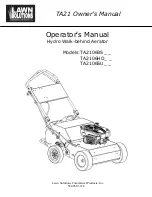
Charge the refrigerant in accordance with the method shown in this section. The weight of the
refrigerant charged must be recorded after the initial charging. Use the next section for trimming
the chiller for optimum operation based on the defined indicators, such as discharge superheat,
sub-cooling, and approaches.
Removing the refrigerant charge for service
Before you begin:
WARNING
To avoid the possibility of freezing liquid within any the chiller tubes when removing refrigerant from a
charged system, the required method is to run the chilled water pumps during this process to eliminate
the risk of tube freezing during the recovery process. The chilled liquid flow must remain present for
the entire refrigerant recovery process. If water flow cannot be maintained, it is imperative that the
chilled liquid be completely drained from the chiller and the waterbox vents and drains are all open
before beginning this process.
Before the removal of any charge into the container(s), for optimal performance, use an empty,
fully evacuated refrigerant container. This ensures that the container is not contaminated and aids
in the efficient removal of refrigerant.
Before removing any refrigerant, establish the starting weight (tare weight) for the refrigerant
cylinder and log the final weight for each container that is used for the recovery. This ensures that
the correct weights are noted for determining the chiller refrigerant charge amount.
Refrigerant weight = Total Container Weight – Tare Weight
While handling refrigerant into or out of any chiller, every precaution must be taken to prevent air
from entering the system when handling the charging lines. Create a suitable charging connection
from new copper tubing or correctly selected flexible charging hoses. Fit this charging connection
between the system service or charging valves and the fitting on the refrigerant container. This
connection must be as short as possible but long enough to provide sufficient flexibility for
changing containers. It must also contain a tee fitting with a valve that can serve as a connection
point to a vacuum pump to evacuate the charging lines.
The charging connection must be evacuated each time the lines are disconnected for changing
cylinders or any of the components of the charging process. The charging line for the refrigerant
liquid must also contain a sight glass. When liquid refrigerant is being handled, the sight glass can
be monitored to determine when the liquid is no longer being transferred to or from the chiller.
1. Navigate to
Condenser/Drain Control
screen and manually set the drain valve to 100% open.
This ensures that any condensed liquid drains to the evaporator.
2. Connect the liquid refrigerant charging connection on the bottom of the evaporator to the
refrigerant container liquid connection only.
3. To help move the liquid refrigerant, you must use a push and pull method to lower the
pressure in the recovery container and raise the chiller system vapor pressure. This method
draws vapor suction from the recovery container vapor connection and discharges into the
condenser vapor connection(s). This allows all liquid refrigerant to be pushed to the recovery
container.
YVAM Control Center
134
Summary of Contents for YORK YVAM 0350
Page 2: ...2 YVAM Control Center...
Page 10: ...Figure 4 Variable speed drive nomenclature YVAM Control Center 10...
Page 15: ...Figure 8 System piping and instrumentation diagram P ID 15 YVAM Control Center...
Page 154: ...Figure 62 Sample printout status or history YVAM Control Center 154...
Page 155: ...Figure 63 Sample printout status or history continued 155 YVAM Control Center...
Page 156: ...Figure 64 Sample printout setpoints YVAM Control Center 156...
Page 157: ...Figure 65 Sample printout setpoints continued 157 YVAM Control Center...
Page 158: ...Figure 66 Sample printout schedule YVAM Control Center 158...
Page 159: ...Figure 67 Sample printout sales order 159 YVAM Control Center...
Page 160: ...Figure 68 Sample printout security log report YVAM Control Center 160...
















































